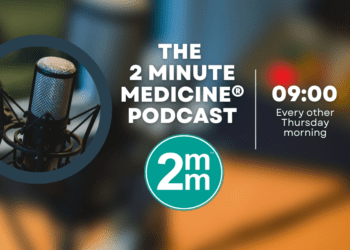Intranasal surfactant does not improve outcomes for children with acute otitis media
1. In a randomized controlled trial (RCT) of over 100 children aged 6-24 months with acute otitis media, adding intranasal surfactant to amoxicillin-clavulanate therapy did not significantly change patient outcomes.
2. Intranasal surfactant use was not associated with increased adverse events.
Evidence Rating Level: 1 (Excellent)
Study Rundown: Acute otitis media (AOM) is one of the most common reasons for presentation to pediatric care. Eustachian tube dysfunction caused by viral upper respiratory infection is part of the pathway to development of AOM. This study explored the use of intranasal surfactant to reduce eustachian tube surface tension and potentially relieve obstruction. 103 children between 6 and 24 months old diagnosed with AOM were randomized to receive either surfactant twice daily for 10 days or intranasal placebo. Patients in both groups received a 10 day course of oral amoxicillin-clavulanate. Parents administered intranasal surfactant or placebo, then recorded children’s symptoms using daily electronic questionnaires. This could have introduced variability to both the therapy itself, including effective dosage, and the measurement of symptom-related outcomes. The primary study endpoints were resolution of bulging tympanic membrane by day 4 and absence of middle-ear effusion at day 12. Surfactant use did not significantly affect these or other measured clinical outcomes, including rates of treatment failure and AOM recurrence. The surfactant group did have a decreased rate of middle ear effusion at all follow up time points that did not reach statistical significance. Due to the study’s small sample size, it is possible that a minor clinical benefit of intranasal surfactant was not detected. Overall, the study shows that the use of intranasal surfactant as an adjunct to antibiotics for the treatment of AOM is unlikely to be clinically beneficial.
Click to read the study in Pediatrics
Relevant Reading: Diagnosis, microbial epidemiology, and antibiotic treatment of acute otitis media in children
In-Depth [randomized controlled trial]: This phase 2a double-blind, randomized controlled trial (RCT) was performed at outpatient pediatric primary care facilities associated with a single academic center in Pittsburgh between February 2018 and February 2019. The planned sample size of 140 was chosen to detect a 25% difference in a primary endpoint. The studied intranasal surfactant, OP0201, was composed of dipalmitoylphosphatidylcholine and cholesteryl palmitate. Patients were followed with otoscopic and endoscopic exams at days 4, 12, and 28. In a modified intention-to-treat analysis using logistic regression and a p-value threshold of 0.05, no statistically significant differences were found in rates of bulging tympanic membrane, middle-ear effusions, treatment failure, AOM relapse or recurrence, or normal tympanogram. Parent-reported symptomatic measures — resolution of symptoms, 50% reduction, and mean acute otitis media-severity of symptoms (AOM-SOS) scores at 10 days — also did not differ.
Image: PD
©2021 2 Minute Medicine, Inc. All rights reserved. No works may be reproduced without expressed written consent from 2 Minute Medicine, Inc. Inquire about licensing here. No article should be construed as medical advice and is not intended as such by the authors or by 2 Minute Medicine, Inc.




![Oral amoxicillin as effective as injectable benzylpenicillin-gentamicin for infants with infection in which referral not possible [AFRINEST Trial]](https://www.2minutemedicine.com/wp-content/uploads/2015/04/NOVAMOXIN_antibiotic-350x250.jpg)


